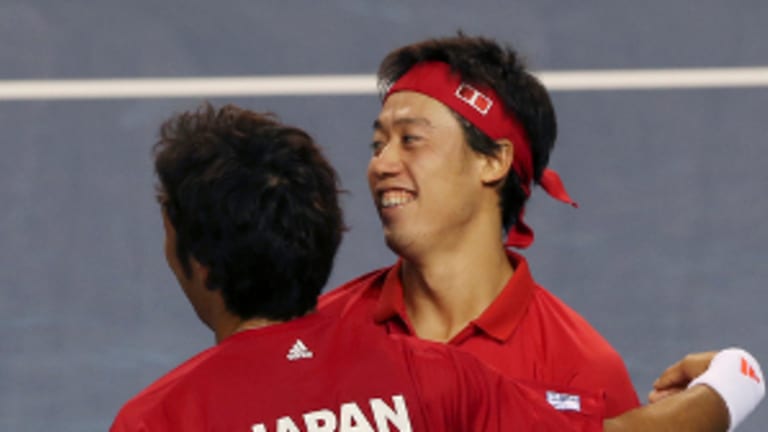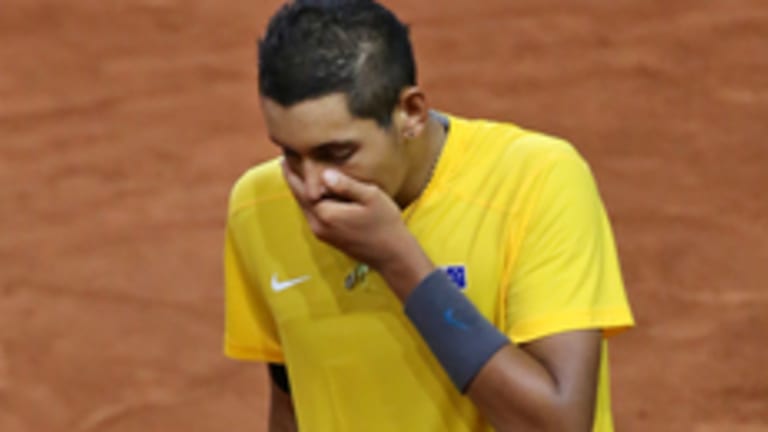Funny, emotional, and flashy Fabio Fognini doesn’t really seem like your classic typical Davis Cup hero. Yet he won three matches (one with doubles partner Simone Bolelli) to lead the charge against the most successful tennis nation to never win the Davis Cup, Argentina.
Things didn’t start out poorly for Argentina, with Carlos Berlocq earning a tie-opening win over Andreas Seppi. Then Fognini took over. He allowed Juan Monaco just nine games in the second rubber, and helped Bolelli win the doubles in four sets—the first three of which ending in tiebreakers. Fognini then put together a masterful four-set win over Berlocq in the fourth rubber to clinch for Italy.
Could it be that the team spirit and pride shown by Italy’s fantastic Fed Cup players is either rubbing off on the men, or shaming them into becoming more adept and enthusiastic Davis Cuppers? I wouldn’t be surprised if that were the case, but in any event, Italy also has a well-balanced squad of solid singles players who are also good at doubles. With a good draw, the Italians could go far.
Next up for Italy: Great Britain, home
(Astana, Kazakhstan; indoor hard)
This one went the distance thanks to a terrific comeback by the Belgians, starting in the doubles. They trailed 2-0 after Andrey Golubev's 12-10 in-the-fifth win over David Goffin, which was preceded by Mikhail Kukushkin's four-set victory over Ruben Bemelmans.
But Bemelmans and Olivier Rochus played an excellent doubles match, winning in four sets to keep the tie alive. The decision to sit Goffin for the doubles seemed an excellent tactical move by Belgian captain Johan Van Herck, because the day of recovery allowed the 23-year-old to recharge his batteries sufficiently; he rallied past Kukishkin to win the fourth rubber, 4-6, 6-3, 3-6, 6-4, 6-0.
But in Davis Cup, you can run, but you can’t hide. Bemelmans had to play three days running, and when it got to that critical, dramatic fifth rubber, he had too little left in the tank, losing to Golubev, 6-2, 6-3, 6-1.
This tie was a tribute to the genius of the Davis Cup format and the cat-and-mouse games it engenders. By resting Goffin after his win a lengthy first rubber, Van Herck bought himself some time and an extended chance, but eventually the reaper came calling.
Next up for Kazakhstan: Switzerland, away
(3-0 live rubbers; Novi Sad, Serbia; indoor hard)
That was some bait-and-switch trick the Swiss played on Novak Djokovic. He and Roger Federer had both declared they wouldn’t be available for this tie, but Federer changed his mind just days before the deadline and joined Stanislas Wawrinka (now No. 3 in the world) to create the team that has to be favored to win the championship.
To make matters worse for the Serbs, the champions of 2010, they were without the services of their other two veteran stars, Viktor Troicki and Janko Tisparevic. Thus, world No. 268 Ilija Bozoljac was little match for Federer.
De facto Serbian No. 1 Dusan Lajovic, who played in last year’s final, pushed Wawrinka to four sets, but it wasn’t nearly enough. To clinch the tie, Marco Chiudinelli and Michael Lammer put forth a great effort to surprisingly shut down the favored Serbian doubles team of Nenad Zimonjic and Filip Krajinovic.
Showing good sense as well as sportsmanship, the Swiss nominated Lammer and Chiudinelli to play the dead rubbers (the Serbs won both). The Swiss are unlikely to face such easy sledding going forward, but with Federer on board—and Spain and Serbia out of the running—the Swiss are the prohibitive tournament favorites.
Next up for Switzerland: Kazakhstan, home


